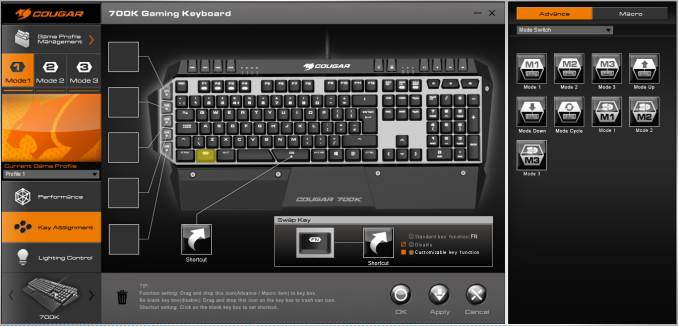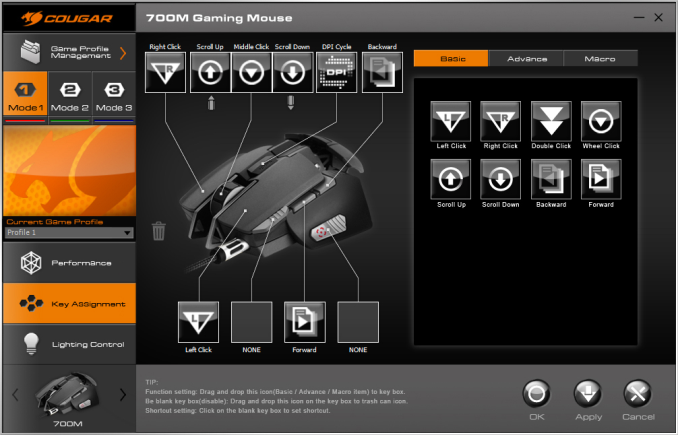Cougar 700K Mechanical Keyboard & 700M Gaming Mouse Review
by E. Fylladitakis on February 23, 2015 3:40 PM EST- Posted in
- Keyboard
- Peripherals
- Cougar
- Mice
- Mechanical Keyboards
Cougar UIX System Software
The UIX System is the software that accompanies all of Cougar's advanced gaming peripherals. It allows the control of multiple devices from the same interface, as well as the transfer of commands from one device to another – and that is the primary reason why we reviewed these two products together in a single article.
In terms of simplicity, the UIX System interface is fairly user friendly and straightforward. Once you install the software modules for the devices that you own, the software recognizes them automatically and will immediately check for software/firmware updates. The user should be careful at that point, as the software does not ask for confirmation once a new firmware has been found – it will immediately proceed with the updating process and forcefully stopping it can permanently damage the device.
For any Cougar device that is connected, the UIX System has three main sections – performance, key assignment, and lighting control. There is also a Game Profile Management section, which allows the user to save multiple profiles. Each profile has up to three modes, allowing on-the-fly setting changes via the keyboard's mode switch keys or other programmed keys. Each mode may have entirely different performance, key, and lighting settings.
For the 700K keyboard, the performance section allows the user to control the polling rate, the key rollover, the repeat delay and acceleration, the backlighting mode, and the sleep mode. The polling rate and key rollover settings are pretty much self-explanatory; you'll want these at the best possible settings (1000 Hz, N-Key Rollover), unless there are compatibility issues with your system. Cougar's repeat delay and acceleration options allow the user to control how quickly an actuated key will start repeating itself and how that repeating will accelerate over time. There is a small test box for the user to check the settings.
The backlighting mode settings allow the user to select from normal "always on" lighting, "click" lighting (the LEDs momentarily light up when the key has been actuated), and three lighting effect modes. One of these three lighting effect modes can be programmed to start automatically once the keyboard enters its "sleep mode", which can be programmed to initiate when no key has been pressed for two to eight minutes (or it can be turned off entirely).
The UIX System also presents the Mode Sync option in this section. If this option is enabled, switching modes using the keyboard's mode selection buttons (or other programmed buttons) will switch the mode of every other Cougar device as well. For example, if Mode 3 is selected from the 700K keyboard, Mode 3 will be activated for the 700M mouse as well. This option can be disabled, allowing the user to switch modes on the keyboard independently from other Cougar devices.
As for the 700M mouse, the performance section is focused on DPI and speed settings. There is an option to adjust the polling rate but, once again, the user should leave that at maximum unless there are compatibility issues. Up to four DPI settings can be programmed in each mode of the 700M, as well as a "Sniper" mode that is active while the corresponding hotkey/button is pressed. The software allows for the separate programming of the X and Y axes, which can lead to very advanced (and complicated) sensitivity options. It is also possible to adjust the lift height, as well as the double click, scroll, and pointer speeds. The scrolling can also be set to "one screen at the time".
A small box enables the hardware acceleration of the mouse – this does not affect the software acceleration of the OS, which needs to be disabled manually. If you want no acceleration at all, the Avago ADNS 9800 Laser sensor can disable the inherent hardware acceleration, or at least reduce it to a level imperceptible by the user, but remember to disable all software acceleration as well.
As there is no ability to change the backlight color, the lighting control of the keyboard is very simple. All the user can do is activate or deactivate the lighting of individual keys. There is a quick option that turns the backlighting of every key on or off as well. It is also possible to adjust the backlight key settings with up to five options, which may include backlight intensity and effect settings. It is not possible to create new effects, however; only preprogrammed effects may be selected. Remember that the lighting settings are tied to the mode – switching modes will switch the lighting settings as well.
The lighting control section of the 700M is very simple as well, but the user has access to RGB lighting. It is possible to adjust the projection color to virtually millions of combinations, but in practice one won't be able to discern the difference between more than a handful of colors. Cougar provides a color wheel and ten preset color settings for convenience. The lighting can also be set at maximum intensity, which is not very strong to begin with, or to a breathing effect.
The key assignment section is very similar for both devices and, as the name suggests, it's the section where the user can change the settings of every key on the keyboard or mouse. When the setting of any key has been changed from its default action, it will turn yellow on the pictured key map. For the keyboard's six macro keys, larger boxes display the programmed functions. The user can select from standard single keystroke actions, advanced options, or programmed macros.
The advanced options include mode switch keys, media functions, and program launch commands. It is interesting that the mouse-related functions can be programmed on the keyboard as well, as for example DPI switch settings and the "Sniper" mode that decreases the DPI setting of the mouse while the key is actuated. This can result in interesting gaming setups, allowing better control of mouse options from the keyboard. For example, for FPS gaming, the Sniper mode can be programmed on the right half of the Spacebar key, allowing faster and more convenient use of this option.
The built-in Macro recorder is relatively simple but very functional. It allows the programming of macros that may or may not include mouse movements (in either absolute or relative coordinates too). It also supports natural, preset, or no delay times between actions. Once the macro has been recorded, delay times and mouse coordinates can be manually edited by double-clicking on them. The macros can be set to play once, repeat a number of times, or repeat continuously until the button has been pressed again.
The macro recorder lacks only two things – the option to return the mouse pointer at its original position after the execution of the macro has been completed and the ability to start/stop recording via a hotkey. Both omissions are equally important but the second will prove to be more annoying, as the software will record both the ALT+TAB keystrokes and the mouse movements from switching back and forth to another application/game, which means manual editing/cleanup of most recorded macros is necessary.



















23 Comments
View All Comments
adamrussell - Thursday, March 19, 2015 - link
Ive been looking for another keyboard without keypad besides the ms sculpt, but not finding it. Can you recommend one? Hopefully ergonomic style? I was under the impression ms sculpt was my only choice for that.Sttm - Monday, February 23, 2015 - link
I'd be embarrassed to have that ugly thing sitting on my desk. The orange on my G710+ is bad enough, but that keyboard, uck.AnnihilatorX - Monday, February 23, 2015 - link
To me the mouse is 100 times worse than the keyboard. I want a gaming oriented mouse that is functional, comfortable and minimalistic instead of looking like something designed by an emo narcissistic teenagerbigboxes - Monday, February 23, 2015 - link
That palm rest is just not right. Look at the right side. Think of where you'd "rest" your right hand in the standard typing position. Yeah... way to the left of the palm rest. Not gonna work.genomecop - Tuesday, February 24, 2015 - link
From the second paragraph of the story. "unfrotunately". Unfortunately no amount of Googling produced the meaning.devione - Tuesday, February 24, 2015 - link
Unfortunately you're unable to articulate yourself without coming across as a massive dick.Cardio - Tuesday, February 24, 2015 - link
Make that Super Massive.mgilbert - Tuesday, February 24, 2015 - link
I just bought a Ducky Legend. I would have liked to have had macro keys, and more than the four media keys on the Legend. I considered the Cougar, but just couldn't handle the yellow backlights. Yellow! Really? The only other option was the Logitech G710, but it felt cheap. How do you make MX Cherry switches feel cheap...SparkySamza - Wednesday, February 25, 2015 - link
But the backlights of the keyboard are red? and plus you can just switch it offwetwareinterface - Friday, February 27, 2015 - link
there is also the corsair k70 rgb in this price range. i got mine for $159. it doesn't have dedicated macro keys but any unused key in your layout can be mapped to trigger macro functions and the macros can include any mouse movement or mouse buttons. that last bit you don't get with the razer software and i'm not sure about logitech as i gave up on the g series when my original g15 refused to have the middle section of keys near u function on certain usb controllers.